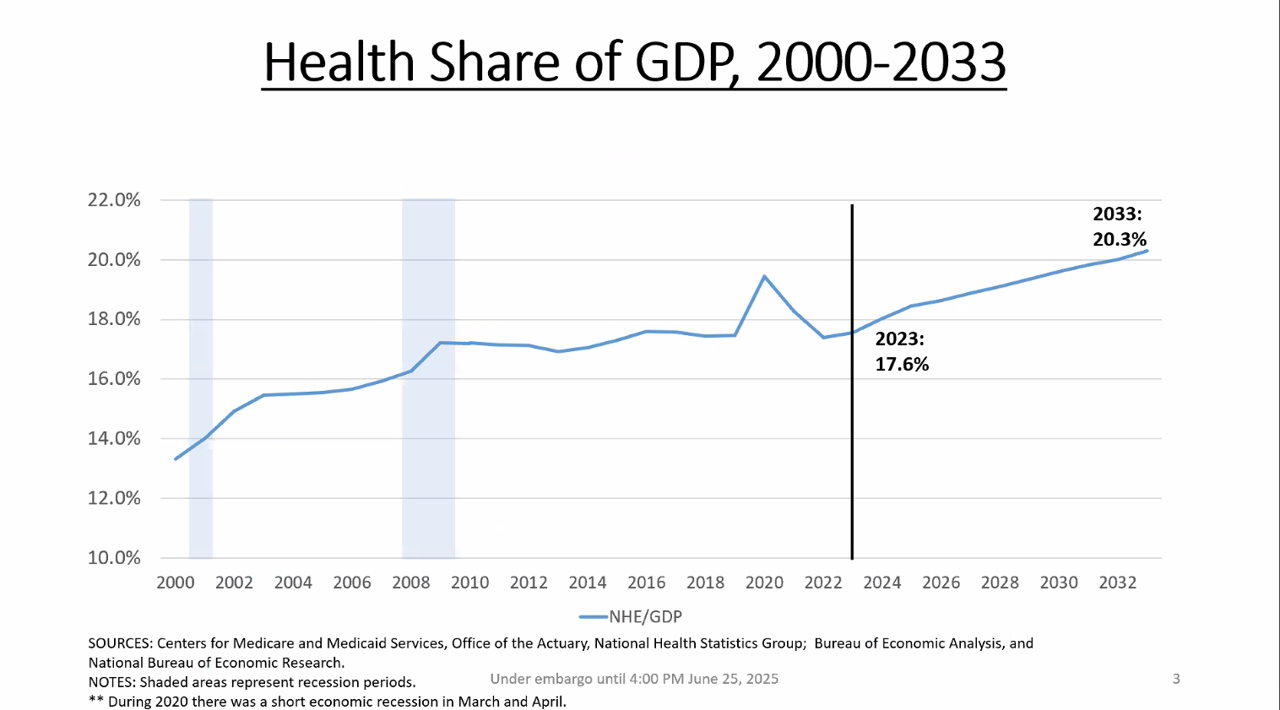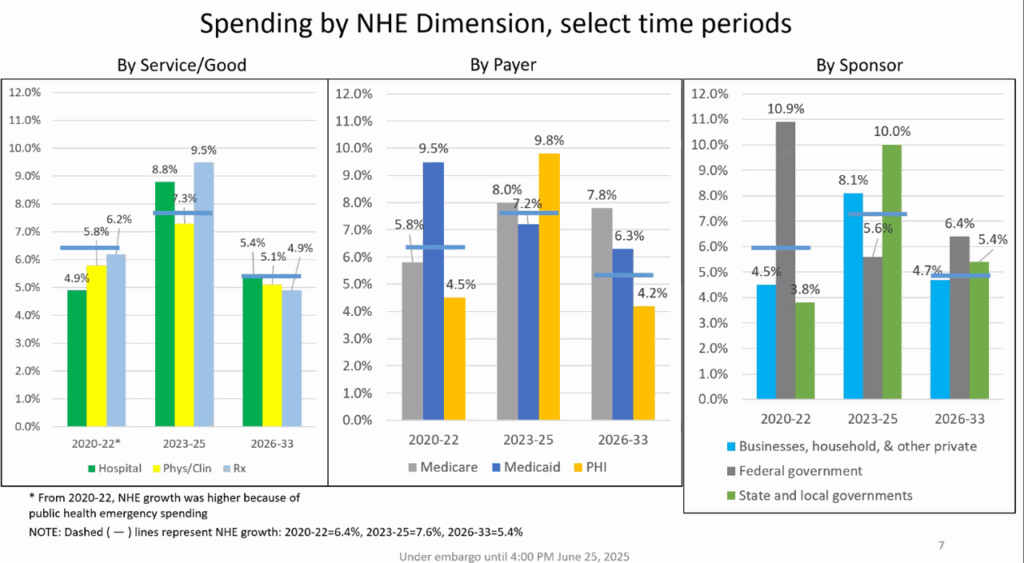HealthPopuli.com – Read More
By 2033, national health spending will comprise 20.3% of the U.S. GDP, based on the latest national health expenditure projections developed by researchers from the Centers for Medicare and Medicaid Services (CMS). This growth will be happening as CMS projects coverage of insured people to decline over the period.

Earlier today, I attended a media briefing hosted by Health Affairs to receive the CMS team’s top-line forecast of NHE from 2024 to 2033 discussing these findings. Fuller details on the projections will be released in the July issue of Health Affairs on 7 July 2025.

The first major finding in the study forecasts that NHE will grow 1.5% faster than the general economy: health spending is expected to increase at 5.8% annually to 2033, with the GDP growing 4.3% per annum.
That pushes the percent of the GDP devoted to NHE to 20.3% in 2033 compared with 17.6% in 2023.

CMS actuaries and statisticians account for NHE through three lenses, which are detailed in this chart highlighting NHE by:
- Service or good (such as hospitals, physician and clinical services, and prescription drugs)
- Payer/source of funding, covering private health insurance (PHI), Medicare, Medicaid, and out-of-pocket spending for patients and plan members, and
- Sponsor or source of financing, namely employers and businesses, households, and governments (Federal, State, and local).
There are some interesting data points to mine in these bar graphs. Consider:
Through the service/good lens (first of the 3 charts), note the blue Rx bar in the time period 2023-25 – the prescription drug (Rx) blue bar reaches 9.5% growth rate, most likely due to the growth of drugs prescribed and adopted by patients to deal with obesity (think: the GLP-1 phenomenon)
Through the Payer lens (the second chart), see the Medicaid enrollment growth decline in 2024 due to the “unwinding” process pushing down the rolls, but the uptake absorbed in part by marketplace plans. Note that Health Affairs‘ sub-title for the study’s release today was, “despite insurance coverage declines, health to grow as share of GDP.”
Through the Sponsor lens (the third chart), we note the growth of 10% to 2025 among State and local governments — which is a relatively high percent — but I will quickly point out that this forecast is based on the existing laws, so does not consider potential impact of the “Big Beautiful Bill,” OBBBA, which could have the direct impact of reducing Medicaid enrollment and programs across the U.S.

Health Populi’s Hot Points: This forecast from Team CMS is always the “gold standard” for national health expenditure statistics, as reinforced by Don Metz, Health Affairs’ current Editor-in-Chief who shepherded the discussion today.
As with all forecasts, and especially for those of us who are neck-deep in scenario planning mode in the current fluid health and social policy environment, we can only know-what-we-know at the moment. And the proviso that this analysis cannot do sensitivity tests on, say, how the Big Beautiful Bill’s Medicaid provisions, or current wrestling for prescription drug spending, could play out in the coming months and years.
The same can be said for private sector health care coverage, as many business sectors are dealing in real time with tariffs’ impacts, labor shortages, the impact of AI on their business processes, and other significant forces re-shaping employers — and their fiscal fitness, which impacts companies’ approaches to benefit design.
For now, we can be certain that health care spending will represent at least $1 in every $5 in 2033. For the U.S. health citizen — as consumer, medical bill payer, caregiver, Chief Health Officer of the home, whatever their persona — our forecast from Health Populi’s/THINK-Health’s lens is that people will take on more health spending based on their values and their sense of value (and value-for-money on that health spending).
Increasingly, health citizens see their health across many layers — physical, fiscal/financial, mental health, social health, and so on. More consumers are taking up the life-flow of food-as-medicine, more adopting wearable tech to track their health (by minutes, hours, or days) both daytime and nighttime (for sleep), and still others are adopting medical-grade tech such as continuous glucose monitors (CGMs) to address their personal metabolic health and weight.
More patients-as-consumers, bill payers, and health citizens will be re-defining health spending not in terms of just their household economics — say, $1.40 in every $5 bill — but also in terms of whether their personal investments meant for overall health and well-being will be bolstering their personal, family, and community flourishing.

That concept is well described in this essay on reconsidering the GDP for health citizens’ well-being — which will increasingly resonate with Americans who are taking on more self-care and attention to moving care to their homes and into their hands.
For more on reimagining health as flourishing, check out this essay from JAMA, going back to 2019, where a trio of health researchers from Harvard identifies those layers of well-being that people value, from the physical to the fiscal, the social, on purpose, and on happiness. The line items are shown in the last graphic from the Viewpoint.
It feels like a good time to revisit this new-old metric for both personal and public policy making.
The post National Health Spending in the U.S. in 2033: What 20.3% of the GDP Will Be Spent On appeared first on HealthPopuli.com.





